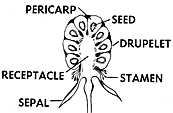Neneleau
Rhus sandwicensis
Sumac family (Anacardiaceae)
Native species ()
Small native tree forming thickets in lowlands, with large leaves and wavy paired except at end, and with whitish almost tasteless sap. To 15–25 ft (4.5–7.6 ) high and 4–12 inches (0.1–43 ) in trunk diameter, spreading by stems from creeping roots. Bark brown gray, smooth. Inner bark whitish within the green outer layer, bitter. Twigs stout, light green, with rusty brown pressed hairs and with hairy rounded buds above U-shaped leaf-scars.

©2015 Forest And Kim Starr
Flower clusters () are erect, very large, 6–12 inches (15–30 ) long, much branched, and finely hairy. Flowers very numerous, crowded, small, about 1⁄8 inch (3 ) long and broad, short-stalked, pale yellow, composed of of five hairy green united at base, of five petals spreading and turned back, five and with and two or three short
() egg-shaped, more than 1⁄8 inch (3 ) long, flattened, reddish, hairy, single-seeded.
The wood is described as yellowish gray with dark resinous streaks, lightweight, coarse-textured, and tough. It has been used for saddle trees on Hawaiian ranches. Formerly, it served for ox yokes and plows. The bark has been used locally for tanning goat skins. According to Degener, a keg of bark was shipped to Boston in 1868. Again in 1918, commercial use was considered but was abandoned because of a fungal disease that killed some plants. The shrubs are showy and ornamental.
Neneleau is found in the lowland forest zone at 600–2000 ft (183–6190 ) elevation or above. Common on the island of Hawaii and uncommon and in scattered or isolated thickets in Kauai, Oahu, Molokai, and Maui. It is common along highways near Hilo, Hawaii, and along the Hamakua coast.
Special area
Waiakea
Range
Hawaii only
Other common name
neleau
Botanical
Rhus chinensis var. sandwicensis (Gray) Deg. & Greenwell, R. semialata Murr. var. sandwicensis (Gray) Engler
This is the only native Hawaiian representative of its family. Several introduced species are better known.
The Hawaiian plants have been treated also as a variety of the Asiatic species Chinese sumac, Rhus chinensis Mill., which ranges from Japan through southern China to India. That species differs in that the leaf axes are winged and it has larger red 5⁄16 inch (8 ) in diameter, reported to be edible.










